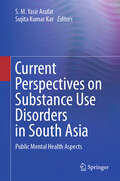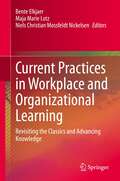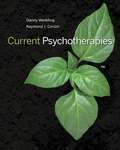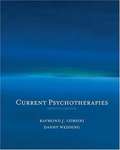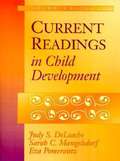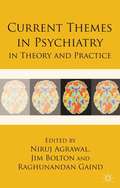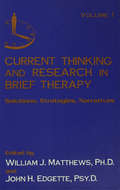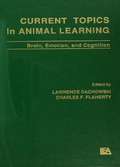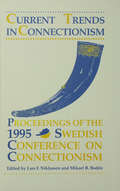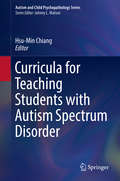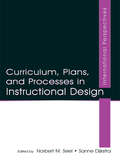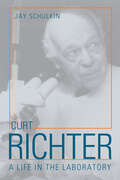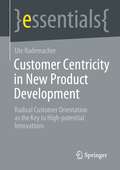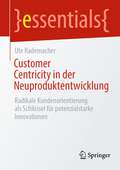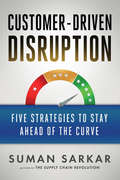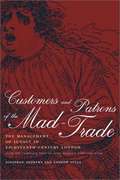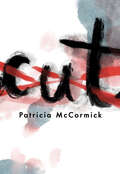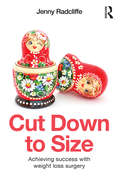- Table View
- List View
Current Perspectives in Social and Behavioral Sciences: Creativity and Reason in Cognitive Development
by James C. KaufmanThis book explores the development of cognitive skills related to reasoning and creativity, two strands that can intertwine to work together at times but may also be at odds. Spontaneity and freedom from constraint, characteristic of the thinking of young children, may be essential to creativity, which has prompted many to question how much we lose as we progress through childhood. Research and common sense tell us that effort, practice, and study are necessary for the highest levels of creative accomplishment, yet such intentional exertions seem antithetical to these hallmarks of creativity. In this revised and expanded second edition, leading scholars shed new light on creativity's complex relationship to the acquisition of domain-based skills and the development of more general logical reasoning skills. Creativity and Reason in Cognitive Development will be an essential reference for researchers, psychologists, and teachers seeking to better understand the most up-to-date work in the field.
Current Perspectives in Social and Behavioral Sciences: Nurturing Creativity in the Classroom
by Beghetto Ronald A. Kaufman James C.As interest in creativity explodes, it has become more complicated to decide how to best nurture creativity in our schools. There are the controversial Common Core Standards in many states. Meanwhile, the classroom has become increasingly digital; it is easier to access information, communicate ideas, and learn from people across the world. Many countries now include cultivating creativity as a national educational policy recommendation, yet there is still debate over best practices. Indeed, many well-intentioned educators may institute programs that may not reach the desired outcome. The notion that schools 'kill creativity' has become a widespread social meme. We view such beliefs as both hyperbolic and problematic: they allow us to recognize there is a problem but not solve it. In this book, a wide array of international experts addresses these issues, discussing theories and research that focus on how to nurture creativity in K-12 and college-level classrooms.
Current Perspectives on Substance Use Disorders in South Asia: Public Mental Health Aspects
by S. M. Yasir Arafat Sujita Kumar KarThis book is about public mental health needs and aspects of substance use disorders in South Asian countries. South Asia consists of eight countries with low- and middle-income backgrounds. The people of this region, with a combined population of around 2 billion, share common cultures, beliefs, and behavioral patterns regarding physical and mental health. Among them, more than 66 million people use different forms of substances including cannabis, opium and opiates, amphetamine, and prescription drugs. Substance abuse brings deadly consequences. It affects almost all spheres of life, i.e., personal, social, recreational, criminal, and family aspects; both physical and mental health; and economy of the society as well as the country. Advanced management and holistic prevention are public health priorities. However, very little attention has been paid to the issues as a region as well as in countries like Afghanistan, Bangladesh, and Pakistan. Hence, the editors of this book aimed to publish a book that discusses the public mental health and healthcare issues related to substance use disorder in a densely populated low- and middle-income setting.
Current Practices in Workplace and Organizational Learning: Revisiting the Classics and Advancing Knowledge
by Bente Elkjaer Maja Marie Lotz Niels Christian Mossfeldt NickelsenThe central assumption that guides this book is that research and practice about learning at the workplace has recently lost its critical edge. This book explores what has happened to workplace learning and organizational learning and studies what has replaced it. In addition, the book discusses to what extend there are reasons to revitalize it. Today, themes such as ‘innovation’, ‘co-creation’ and ‘knowledge sharing’ seem to have become preferred and referred to as theoretical fields as well as fields of practice. In several chapters of this book it is argued that the critical power of learning could be regained by starting a new discussion of how these new fields of practice can be substantiated by topics such as learning arrangements, learning mechanisms, and learning strategies. Hence, the aim of this book is to both advance and recapture our knowledge of learning in today’s increasingly complex world of work and organizing. The contributions in this work do so by revisiting classic research on workplace and organizational learning and discussing how insights from this body of literature evokes new meaning. It sets the stage for new agendas and rethinks current practices that are entangled in activities such as innovation, co-creation, knowledge sharing or other currently widespread fields of practice.
Current Psychotherapies
by Raymond J. Corsini Danny WeddingNow in its eleventh edition and used in top Counseling, Psychology and Social Work programs, CURRENT PSYCHOTHERAPIES helps you learn, compare and apply the major systems of psychotherapy in a way that will be meaningful in your future practice. Every chapter is written by either an originator or a leading proponent of a system. Each of these distinguished figures describes the basic principles of the system and highlights how it differs from other systems. A case example in every theory chapter guides you through the problem, evaluation, treatment and follow-up process.
Current Psychotherapies (7th edition)
by Raymond J. Corsini Danny WeddingThe 14 chapters in this counseling textbook describe the most important systems in the current practice of psychotherapy, summarizing each's history, theories of personality, treatment methods, and application to different disorders. The eighth edition adds chapters on integrative and contemplative psychotherapies and removes the chapters on experiential psychotherapy and psychodrama.
Current Readings in Child Development 3rd Edition
by Judy Deloache Sarah C. Mangelsdorf Eva PomerantzThis book is designed to introduce readers to some of the most interesting and important current research in the field of child development.
Current Themes in Psychiatry in Theory and Practice
by Niruj Agrawal Jim Bolton Raghunandan GaindAn up-to-date overview of a range of topics, covering contemporary concerns and therapeutic challenges in clinical psychiatry, written by distinguished psychiatrists who are leaders in their fields. This volume will help to shape the clinical practice of psychiatry students and mental health professionals.
Current Theories of Psychoanalysis
by Robert LangsEach chapter is written by one or more contributors who make the case for the particular version of psychoanalytic theory and practice to which they are committed
Current Thinking and Research in Brief Therapy: Solutions, Strategies And Narratives
by William Matthews John EdgetteIn Volume 2 of Current Thinking and Research in Brief Therapy the author's consideration of Ericksonian-influenced brief therapy continues. Presently, there is a concern among those in the psychotherapy profession who worry that this area of science will become heartless. Others are equally concerned that their hearts not become science-less in the future. In this volume, the authors respect both viewpoints and attempt to weave these notions together.Throughout this book, different types of emotions in psychotherapy unfold. For instance, Harry Aponte presents a thoughtful piece on the issue of client-therapy intimacy, while Doug Flemons and Shelley Green, a married couple, share a humorous yet sensitive article on sexual concerns in couples, and finally, Daniel Handel provides a powerful story of the use of hypnosis with a dying adolescent.In addition to the emotional side of psychotherapy, the authors include the scientific aspects of psychotherapy. A discussion about various models of brief therapy is given, emphasizing that the therapeutic effects of the treatment models are attributable to "the non-treatment specifics" of the therapeutic interaction. A review of empirical data on the key elements of Ericksonian hypnosis and the social-psychological aspect of Ericksonian hypnosis are discussed as well. Finally, an important, and perhaps controversial, essay on ethics in the general non-therapeutic use of hypnosis by lawyers and its use in recovering memories is presented.
Current Topics in Animal Learning: Brain, Emotion, and Cognition
by Lawrence Dachowski Charles F. Flaherty Alison HartmanThis book, based on the Flowerree Mardi Gras Symposium at Tulane University, juxtaposes contemporary research and theory from several areas of animal learning -- learning theory, comparative cognition, animal models of human behavior, and functional neurology. Investigators pursuing these different routes often work in isolation of progress being made in, what should be, related fields. This book will acquaint students and researchers with a variety of topics, ordinarily treated separately, in a way that will stimulate integrative thinking. Cognitive interpretations of animal learning are included, as well as recent developments in conditioning theory, physiological bases of learning, animal models of human behavior problems, and psychopharmacology.
Current Topics in the Theory and Application of Latent Variable Models
by Michael C. Edwards Robert C. MacCallumThis book presents recent developments in the theory and application of latent variable models (LVMs) by some of the most prominent researchers in the field. Topics covered involve a range of LVM frameworks including item response theory, structural equation modeling, factor analysis, and latent curve modeling, as well as various non-standard data structures and innovative applications. The book is divided into two sections, although several chapters cross these content boundaries. Part one focuses on complexities which involve the adaptation of latent variables models in research problems where real-world conditions do not match conventional assumptions. Chapters in this section cover issues such as analysis of dyadic data and complex survey data, as well as analysis of categorical variables. Part two of the book focuses on drawing real-world meaning from results obtained in LVMs. In this section there are chapters examining issues involving assessment of model fit, the nature of uncertainty in parameter estimates, inferences, and the nature of latent variables and individual differences. This book appeals to researchers and graduate students interested in the theory and application of latent variable models. As such, it serves as a supplementary reading in graduate level courses on latent variable models. Prerequisites include basic knowledge of latent variable models.
Current Trends in Connectionism: Proceedings of the 1995 Swedish Conference on Connectionism
by Lars F. Niklasson Mikael B. BodIn order to build "intelligent" machines, many researchers have turned to the only naturally occurring intelligent system: the brain. For quite a while now, both the function and architecture of the brain have served as inspiration to philosophers, psychologists, computer scientists, neurobiologists, physicists and others in their quest for solving problems that seem to require intelligence in their own particular domain. The progress in the field of connectionism -- or artificial neural networks -- has had its ups and downs during its maturing years. Advocates of the field pointed out the virtues of connectionist systems, dealing with low-level cognitive tasks such as visual recognition and pattern completion, and inherent properties such as generalization, fault tolerance and parallel processing. However, research in the field virtually came to a halt at the end of the 1960s when Minsky and Papert published their critical analysis of connectionist systems, Perceptrons. In the beginning of the 1980s, the field was reborn with the appearance of new powerful learning methods which overcame many of the computational problems identified by Minsky and Papert. This volume is characterized by a number of different research directions distinguished by their perspectives on systems comprising interconnected sets of simple processing elements. Scientists who have strong backgrounds in neurobiology concentrate on the issues involved when modelling natural systems. Researchers with philosophical and psychological backgrounds stress other aspects which might not always be intuitively relevant to biology but instead are concerned with the mind and its higher-order cognitive capabilities. On the other hand, many researchers and engineers in industry take advantage of the wide applicability and mathematical properties of connectionist systems in order to solve practical problems, sacrificing even more of the principles underlying the basic idea of mimicking the function and architecture of the brain. None of these directions are right or wrong, but there has perhaps been too little exchange of knowledge and experience between them. The main purpose for organizing this conference was to bring together researchers with different backgrounds to exchange ideas and visions in the broad field of connectionism -- providing means for new insights that may push this area to another major breakthrough.
Current and Future Perspectives of Ethnomathematics as a Program (ICME-13 Topical Surveys)
by Milton Rosa Ubiratan D'Ambrosio Daniel Clark Orey Lawrence Shirley Wilfredo V. Alangui Pedro Palhares Maria Elena GavarreteThis surveyon the modernity of ethnomathematics addresses numerousthemes related both to ethnomathematics and culturally relevant pedagogy. Itoffers a broader view of mathematics, including ideas, concepts, procedures,processes, methods and practices rooted in distinct cultural environments. Inaddition, by reflecting on the social and political dimensions ofethnomathematics, another important aspect of this research program is thedevelopment of innovative approaches for a dynamic and globalizedsociety. Ethnomathematics recognizes that members of different culturesdevelop unique mathematical techniques, methods and explanations that allow foran alternative understanding and transformation of societal norms. Thetheoretical basis of ethnomathematics offers a valid alternative to traditionalstudies of history, philosophy, cognition and pedagogical aspects ofmathematics. Ethnomathematics' current agenda is to continue an ongoing,progressive trajectory that contributes to the achievement of social justice, peaceand dignity for all.
Curricula for Teaching Students with Autism Spectrum Disorder (Autism and Child Psychopathology Series)
by Hsu-Min ChiangThis book provides an extensive overview of curricula and instructional strategies for teaching children with autism spectrum disorder (ASD). It offers an empirically solid framework for designing and developing interventions for learners along the autism spectrum by reducing skill deficits and enhancing learner strengths while being flexible enough to allow for individual differences. The book discusses key concepts in educating individuals with ASD as they impact the processes of syllabus building, from planning goals and objectives to generating content choosing appropriate teaching strategies, and assessing progress. Chapters detail curriculum designs in academic areas such as language skills, science, and social studies, as well as functional skills, including independent living, career development, and preventing social victimization. The book concludes with recommendations for future interventions and curricula-building. Among the topics covered: Communication and autism spectrum disorder. Mathematical problem-solving instruction for students with ASD. Visual arts curriculum for students with ASD. How to build programs focused on daily living and adult independence. Sexuality education for students with ASD. Curricula for Teaching Students with Autism Spectrum Disorder is a must-have resource for researchers, graduate students, and clinicians and related therapists and professionals in clinical child and school psychology, childhood/special education, social work, developmental psychology, behavioral therapy/rehabilitation, and child and adolescent psychiatry.
Curriculum models for the 21st century: Using Learning Technologies in Higher Education
by Dirk Ifenthaler Maree GosperChanging student profiles and the increasing availability of mainstream and specialized learning technologies are stretching the traditional face-to-face models of teaching and learning in higher education. Institutions, too, are facing far-reaching systemic changes which are placing strains on existing resources and physical infrastructure and calling into question traditional ways of teaching through lectures and tutorials. And, with an ever-increasing scrutiny on teaching and teachers' accountability for positive educational outcomes, the call for closer attention to learning, teaching and, most especially, to the design and delivery of the curriculum is given increasing relevance and importance. Research provides strong evidence of the potential for technologies to facilitate not only cognition and learning but also to become integral components in the redesign of current curriculum models. Some Universities and individual academics have moved along this pathway, developing new and innovative curriculum, blending pedagogies and technologies to suit their circumstances. Yet, there are others, unsure of the possibilities, the opportunities and constraints in these changing times. Curriculum Models for the 21st Century gives insights into how teaching and learning can be done differently. The focus is on a whole of curriculum approach, looking at theoretical models and examples of practice which capitalize on the potential of technologies to deliver variations and alternatives to the more traditional lecture-based model of University teaching.
Curriculum, Plans, and Processes in Instructional Design: International Perspectives
by Norbert M. Seel Sanne DijkstraCurriculum, Plans, and Processes in Instructional Design: International Perspectives presents perspectives on the relationship between curriculum research and instructional design, as well as new developments in the use of information and communication technology. In their introductory chapter, the editors provide an overview of the volume and introduce the discussions found in three sections: *The chapters in Part I (Theoretical Foundations and Innovations) describe and discuss new theoretical and innovative approaches to instructional design that integrate curriculum development with information and communication technologies. *Part II (Curriculum Development, Instructional Design, and Information Technology) focuses on curriculum development and its impact on models of instructional design. *Part III (Information and Communication Technology and Instructional Design) addresses the challenge of advancing information and communication technologies for instructional planning and curriculum development. Prominent researchers and practitioners from instructional design, as well as the learning sciences--from both the U.S. and around the world--have contributed to this volume. This volume is a valuable resource for graduate students, scholars, and researchers in the fields of instructional design and educational technology, as well as for those who wish to develop expertise in training in industrial, military, public and academic organizations.
Curt Richter: A Life in the Laboratory
by Jay SchulkinIn the first half of the twentieth century, psychology was a discipline in search of scientific legitimacy. Debates raged over how much of human and animal behavior is instinctive and how much is learned, and how behavior could be quantified accurately. At the Johns Hopkins University's new Phipps Psychiatric Clinic, Curt P. Richter stood aside from these heated theoretical arguments, choosing instead to apply his data-collection methods, innovative measurement techniques, playful sense of exploration, and consummate surgical skill to laboratory examinations of the biological basis of behavior. From identifying the biological clocks that govern behavior and physiology to observing the self-regulation of nutrient levels by the body, the cyclical nature of some mental illnesses, and the causes of hopelessness, Richter's wide-ranging discoveries not only influenced the burgeoning field of psychobiology and paved the way for later researchers but also often had implications for the treatment of patients in the clinic. At the time of his death in 1988, Richter left behind a massive collection of laboratory data. For this book, Jay Schulkin mined six decades of Richter's archived research data, personal documents, and interviews to flesh out an engaging portrait of a "laboratory artisan" in the context of his work.
Curtains: Adventures of an Undertaker-in-Training
by Tom Jokinen"Two rules for picking up a body at the hospital, known as a 'removal': (1) Make sure it's the right one. (2) Never stop for food on the way back to the funeral home, not even at a drive-thru. " Jokinen, now a radio producer and video journalist, tells of his apprenticeship, at age 44, in a small, family-owned funeral home. With gentle humor and compassion, he writes about the people he worked with, who have been in the industry all of their lives, as well as the many bereaved families he observed during his apprenticeship. Interwoven with accounts of his bumbling attempts to collect corpses, embalm them, and drive a hearse, are explorations of our culture's rapidly changing relationship with death and the dead. Particularly moving is a comparison of the latest consumer trends for funerals with the simple rituals of the Mennonites of the rural Midwest. Annotation ©2011 Book News, Inc. , Portland, OR (booknews. com)
Customer Centricity in New Product Development: Radical Customer Orientation as the Key to High-potential Innovations (essentials)
by Ute RademacherThe pressure on companies to innovate is increasing. Market conditions are becoming more volatile. The number of competitors is increasing. New business models are upsetting old structures. And customers are increasingly well informed and digitally connected. Only offers that provide comprehensible and credible solutions for a company's own pain points can prevail.
Customer Centricity in der Neuproduktentwicklung: Radikale Kundenorientierung als Schlüssel für potenzialstarke Innovationen (essentials)
by Ute RademacherDer Innovationsdruck auf Unternehmen steigt. Die Marktbedingungen werden volatiler. Die Zahl der Mitbewerber:innen steigt. Neue Geschäftsmodelle wirbeln alte Strukturen durcheinander. Und Kund:innen sind immer besser informiert und digital vernetzt. Nur Angebote, die verständliche und glaubwürdige Lösungen für die eigenen „Pain Points“ liefern, können sich durchsetzen.
Customer-Driven Disruption: Five Strategies to Stay Ahead of the Curve
by Suman SarkarBusinesses worry about new technologies, but customers are the ultimate disruptors—Suman Sarkar offers bold strategies for making sure you understand your customers and keep up with their ever-changing needs.Disruption—the brutal roiling of markets, the decline of long-established brands and products, and the rise of new upstarts—drives business failure and success. Most people think technology causes disruption, but technology merely enables it. Changing customer needs cause disruptions, and too many businesses get caught unaware. Suman Sarkar offers proven strategies that will enable any business to stay radically close to its customers and address their evolving needs. He argues that businesses need to focus on existing customers first—research shows they're likely to spend more and are more profitable than new customers. Personalization is becoming important for the newer generations in both developed and developing markets, so Sarkar describes approaches to make them cost-effective. In our era of instant gratification, customers want what they want now—Sarkar explains how you can develop and deliver products and services faster than ever. And since a few bad Yelp reviews, social media posts, or angry tweets from customers can ruin you, Sarkar shows how to proactively make sure the quality of your products and services stays better than that of your competitors. The key to survival in this era of changing customer needs is to focus on and address them quickly so customers don't switch to the competition. Drawing on his experiences with leading companies worldwide, Sarkar offers five strategies and techniques that will keep you ahead of the curve.
Customers and Patrons of the Mad-trade: With the Complete Text of John Monro's 1766 Case Book
by Jonathan Andrews Andrew T. ScullAn important, nuanced, and fascinating account of the socio-cultural milieu that shaped and constituted the 18th-century mad-trade, centered around the clinical practice of the most famous psychiatrist in 18th-century England.
Cut
by Patricia McCormickAn astonishing novel about pain, release, and recovery from two-time National Book Award finalist, Patricia McCormick.A tingle arced across my scalp. The floor tipped up at me and my body spiraled away. Then I was on the ceiling looking down, waiting to see what would happen next.Callie cuts herself. Never too deep, never enough to die. But enough to feel the pain. Enough to feel the scream inside.Now she's at Sea Pines, a "residential treatment facility" filled with girls struggling with problems of their own. Callie doesn't want to have anything to do with them. She doesn't want to have anything to do with anyone. She won't even speak.But Callie can only stay silent for so long...
Cut Down to Size: Achieving success with weight loss surgery
by Jenny RadcliffeCut Down to Size covers everything you need to know about bariatric surgery, from referral through to the challenges you may face after surgery. Most people who seek weight loss surgery have struggled for many years to control their eating, and have experienced increasing health limitations, self-consciousness and discrimination. People see weight loss surgery as their last chance for a better, more normal life. While hopeful fantasies about an alternative future make it hard to contemplate the risk of failure, some patients experience considerable emotional or physical problems. This book offers insight into the realities of living with weight loss surgery, and practical exercises help you think through your emotional readiness, social circumstances and eating habits that could determine the success of surgery. Active preparation for surgery by making psychological and lifestyle changes puts you in the best position to achieve better health and emotional wellbeing. Cut Down to Size is the first book to focus on the psychological and social aspects of weight loss surgery and will be of interest to health professionals as well as anyone contemplating weight loss surgery. By sharing the experiences of other bariatric patients, the reader can appreciate the nature of life after surgery and make a judgement about their capacity to cope with these demands.

